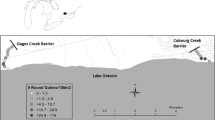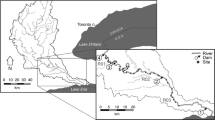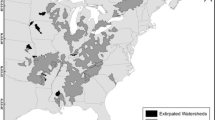Abstract
Understanding habitat use and reproductive biology of invasive species is essential to predicting invasions, designing early detection programs, and developing management plans. The rudd (Scardinius erythrophthalmus; Linnaeus, 1758) is an omnivorous fish native to Europe and western Asia that has been translocated to several countries in western Europe, New Zealand, North America, and Africa. However, little is known about early life history of rudd, particularly in invaded ecosystems, limiting our ability to predict invasions and create early detection and control programs. The upper Niagara River has the most abundant population of rudd in North America and has been the focus of several ecological investigations. Our study identified critical nursery habitats by determining which nearshore habitat factors were most strongly associated with presence of age-0 rudd. We found that emergent vegetation was the most important habitat characteristic associated with the presence of age-0 rudd. When emergent vegetation was not present, rudd were more likely to be present at sites with abundant submerged aquatic vegetation. Additionally, the odds of rudd presence decreased as distance to the nearest wetland increased. These findings can be used to create habitat-driven predictive models of rudd invasion and guide early detection programs for rudd outside their native range.



Similar content being viewed by others
Availability of data and material
Available upon request.
Code availability
Available upon request.
References
Bajer, P. G. & P. W. Sorensen, 2010. Recruitment and abundance of an invasive fish, the common carp, is driven by its propensity to invade and reproduce in basins that experience winter-time hypoxia in interconnected lakes. Biological Invasions 12(5): 1101-1112.
Bajer, P. G., C. J. Chizinski & P. W. Sorensen, 2011. Using the Judas technique to locate and remove wintertime aggregations of invasive common carp. Fisheries Management and Ecology 18: 497-505.
Bajer, P. G., Chizinski, C. J., Silbernagel, J. J. & P. W. Sorensen, 2012. Variation in native micro-predator abundance explains recruitment of a mobile invasive fish, the common carp, in a naturally unstable environment. Biological Invasions 14(9): 1919-1929.
Bajer, P. G., T. K. Cross, J. D. Lechelt, C. J. Chizinski, M. J. Weber & P. W. Sorensen, 2015. Across‐ecoregion analysis suggests a hierarchy of ecological filters that regulate recruitment of a globally invasive fish. Diversity and Distributions 21(5): 500-510.
Burkhead, N. M. & J. D. Williams, 1991. An intergeneric hybrid of a native minnow, the golden shiner, and an exotic minnow, the rudd. Transactions of the American Fisheries Society 120: 781–795.
Burnham, K. P. & D. R. Anderson, 2002. Model selection and multimodel inference: a practical information-theoretic approach. Springer, New York, New York.
Cadwallader, P. L., 1978. Acclimatisation of rudd Scardinius erythrophthalmus (Pisces: Cyprinidae), in the North Island of New Zealand (Note). New Zealand Journal of Marine and Freshwater Research 12: 81–82.
Calcagno, V. 2020. glmulti: Model Selection and Multimodel Inference Made Easy. R package version 1.0.8. https://CRAN.R-project.org/package=glmulti
Chambers, J. M., W. S. Cleveland, B. Kleiner & P. A. Tukey, 1983. Graphical Methods for Data Analysis. Belmont, California: Wadsworth International Group.
Cooper, M. J., G. A. Lamberti, A. H. Moerke, C. R. Ruetz III, D. A. Wilcox, V. J. Brady, T. N. Brown, J. J. H. Ciborowski, J. P. Gathman, G. P. Grabas, L. B. Johnson & D. G. Uzarski, 2018. An expanded fish-based index of biotic integrity for Great Lakes coastal wetlands. Environmental Monitoring and Assessment. 190: 580.
Crane, D. P., J. M. Farrell & K. L. Kapuscinski, 2014. Identifying important micro-habitat characteristics of muskellunge spawning locations in the upper Niagara River. Journal of Great Lakes Research 40: 325-335.
Crane, D. P. & K. L. Kapuscinski, 2017. Habitat use by age-0 muskellunge in the upper Niagara River. In Proceedings of Hugh Becker Memorial Muskellunge Symposium: 50 years of Management, Research and Cooperation. American Fisheries Society, Bethesda, Maryland. pp 227–240.
Crane, D. P. & K. L. Kapuscinski, 2018. Capture efficiency of a fine mesh seine in a large river: Implications for abundance, richness, and diversity analyses. Fisheries Research 205: 149-157.
Crane, D. P., K. L. Kapuscinski & J. J. Hutchens Jr, 2020. Use of a novel richness-weighted abundance index of age-0 fishes to identify key features for habitat conservation and restoration. Ecological Indicators 117: 106713.
Eklöv, P. & S. F. Hamrin, 1989. Predatory efficiency and prey selection: interactions between pike Esox lucius, perch Perca fluviatilis and rudd Scardinius erythrophthalmus. Oikos 149-156.
Fox, J. & S. Weisberg. 2019. An R Companion to Applied Regression, Third edition. Sage, Thousand Oaks, California. https://socialsciences.mcmaster.ca/jfox/Books/Companion/
Gallagher, A. S. & N. J. Stevenson, 1999. Streamflow. Aquatic habitat assessment: common methods. American Fisheries Society, Bethesda, Maryland, pp 149–157.
Guinan, E. G., K. L. Kapuscinski & M. A. Teece, 2015. Seasonal diet shifts and trophic position of an invasive cyprinid, the rudd Scardinius erythrophthalmus (Linnaeus, 1758), in the upper Niagara River. Aquatic Invasions 10: 217-225.
Hicks, B. J. 2003. Biology and potential impacts of rudd (Scardinius erythrophthalmus L.) in New Zealand. Managing Invasive Freshwater Fish in New Zealand: proceedings of a workshop hosted by Department of Conservation, Wellington, New Zealand, pp 49–58.
Johansson, L., 1987. Experimental evidence for interactive habitat segregation between roach (Rutilus rutilus) and rudd (Scardinius erythrophthalmus) in a shallow eutrophic lake. Oecologia 73: 21–27.
Kapuscinski, K. L., J. M. Farrell & M. A. Wilkinson, 2012. First report of abundant rudd populations in North America. North American Journal of Fisheries Management 32: 82–86.
Kapuscinski, K. L., J. M. Farrell & M. A. Wilkinson, 2012. Feeding patterns and population structure of an invasive cyprinid, the rudd Scardinius erythrophthalmus (Cypriniformes, Cyprinidae), in Buffalo Harbor (Lake Erie) and the upper Niagara River. Hydrobiologia 693: 169-181.
Kapuscinski, K.L. & J.M. Farrell, 2014. Habitat factors influencing fish assemblages at muskellunge nursery sites. Journal of Great Lakes Research 40:135–147. DOI: https://doi.org/10.1016/j.jglr.2012.11.007
Kapuscinski, K. L., J. M. Farrell, S. V. Stehman, G. L. Boyer, D. D. Fernando, M. A. Teece & T. J. Tschaplinski, 2014. Selective herbivory by an invasive cyprinid, the rudd Scardinius erythrophthalmus. Freshwater Biology 59: 2315-2327.
Kapuscinski, K. L., J. M. Farrell & M. A. Wilkinson, 2015. Abundance, biomass, and macrophytes consumption by rudd in Buffalo Harbor and the Niagara River, and potential herbivory by grass carp. Journal of Great Lakes Research 41: 387-395.
Kennedy, M. & P. Fitzmaurice, 1974. Biology of the rudd Scardinius erythrophthalmus (L) in Irish waters. Proceedings of the Royal Irish Academy. Section B: biological, geological, and chemical science 74: 245-303.
Killourhy, C. C., D. P. Crane & S. V. Stehman, 2016. Precision and accuracy of visual aquatic habitat estimates. Freshwater Science 35: 1062–1072.
Klindt, R. 1990. Distribution of rudd in the St. Lawrence River. St. Lawrence River Subcommittee, Report to the Great Lakes Fishery Commission, New York State Department of Environmental Conservation, Albany.
Klindt, R. 1991. Rudd in the St. Lawrence River: 1989–1990. St. Lawrence River Subcommittee, Report to the Great Lakes Fishery Commission, New York State Department of Environmental Conservation, Albany.
Kulhanek, S.A., A. Ricciardi, and B. Leung, 2011. Is invasion history a useful tool for predicting the impacts of the world's worst aquatic invasive species? Ecological Applications 21(1):189-202.
Lake, M. D., B. J. Hicks, R. D. S. Wells & T. M. Dugdale, 2002. Consumption of submerged aquatic macrophytes by rudd (Scardinius erythrophthalmus L.) in New Zealand. Hydrobiologia 470: 13–22.
Lüdecke, D., (2018). ggeffects: Tidy Data Frames of Marginal Effects from Regression Models. Journal of Open Source Software 3(26):772. https://doi.org/https://doi.org/10.21105/joss.00772
Nico, L., P. Fuller & G. Jacobs. 2010. Scardinius erythrophthalmus. USGS Nonindigenous Aquatic Species Database, Gainesville, FL. http://nas3.er.usgs.gov/queries/FactSheet.aspx?speciesID=648. Accessed August 2020.
Peduzzi, P., J. Concato, E. Kemper, T. R. Holford & A. R. Feinstein, 1996. A simulation study of the number of events per variable in logistic regression analysis. Journal of Clinical Epidemiology. 49:1373–1379.
Poole, J. R. & P. G. Bajer, 2019. A small native predator reduces reproductive success of a large invasive fish as revealed by whole-lake experiments. PloS one 14(4): e0214009.
R Core Team. (2013) R: A language and environment for statistical computing. R Foundation for Statistical Computing, Vienna, Austria. http://www.R-project.org/
R Studio Team. (2015). RStudio: Integrated Development for R. RStudio, Inc., Boston, Massachusetts. http://www.rstudio.com/
Radomski, P. & T. J. Goeman, 2001. Consequences of human lakeshore development on emergent and floating leaf vegetation abundance. North American Journal of Fisheries Management 21: 46–61.
Reaser, J. K., S. W. Burgiel, J. Kirkey, K. A. Brantley, S. D. Veatch & J. Burgos-Rodríguez, 2020. The early detection of and rapid response (EDRR) to invasive species: a conceptual framework and federal capacities assessment. Biological Invasions 22: 1-19.
Robin, X., N. Turck, A. Hainard, N. Tiberti, F. Lisacek, J. Sanchez & M. Müller, 2011. pROC: an open-source package for R and S+ to analyze and compare ROC curves. BMC Bioinformatics, 12, p. 77. https://doi.org/10.1186/1471-2105-12-77. http://www.biomedcentral.com/1471-2105/12/77/
Sharma, S., D. A. Jackson, C. K. Minns, & B. J. Shuter, 2007. Will northern fish populations be in hot water because of climate change? Global Change Biology. 13: 2052-2064.
Simberloff, D., 2003. How much information on population biology is needed to manage introduced species? Conservation Biology. 17: 83-92.
Siriwardena, S. 2019. Scardinius erythrophthalmus (rudd). Invasive Species Compendium. CAB International, Wallingford, UK. http://www.cabi.org/isc/datasheet/65689. Accessed August 2020.
Sorensen, P. W. & P. G. Bajer, 2020. Case studies demonstrate that common carp can be sustainably reduced by exploiting source-sink dynamics in Midwestern Lakes. Fishes. DOI: https://doi.org/10.3390/fishes5040036
Stantec Consulting Services, Inc., 2005. Effect of water level and flow fluctuations on aquatic and terrestrial habitat. Niagara Power Project, FERC No. 2216
Uzarski, D. G., V. J. Brady, M. J. Cooper, D. A. Wilcox, D. A. Albert, R. P. Axler, P. Bostwick, T. N. Brown, J. J. H. Ciborowski, N. P. Danz, J. P. Gathman, T. M. Gehring, G. P. Grabas, A. Garwood, R. W. Howe, L. B. Johnson, G. A. Lamberti, A. H. Moerke, B. A. Murry, G. J. Niemi, C. J. Norment, C. R. Ruetz III, A. D. Steinman, D. C. Tozer, R. Wheeler, T. K. O’Donnell & J. P. Schneider, 2017. Standardized measures of coastal wetland condition: implementation at a Laurentian Great Lakes Basin-wide scale. Wetlands 37: 15-32.
Vander Zanden, M. J., G. J. Hansen, S. N. Higgins & M. S. Kornis, 2010. A pound of prevention, plus a pound of cure: early detection and eradication of invasive species in the Laurentian Great Lakes. Journal of Great Lakes Research 36: 199-205.
Vittinghoff, E. & C. E. McCulloch, 2007. Relaxing the rule of ten events per variable in logistic and Cox regression. American Journal of Epidemiology. 165:710–718.
Weber, M. J., M. J. Hennen, M. L. Brown, D. O. Lucchesi & T. R. S. Sauver, 2016. Compensatory response of invasive common carp Cyprinus carpio to harvest. Fisheries Research 179: 168-178.
Williams, S. L., & E. D. Grosholz, 2008. The invasive species challenge in estuarine and coastal environments: marrying management and science. Estuaries and Coasts 31: 3-20.
Zelasko, K. A., K. R. Bestgen, J. A. Hawkins & G. C. White, 2016. Evaluation of a long-term predator removal program: abundance and population dynamics of invasive northern pike in the Yampa River, Colorado. Transactions of the American Fisheries Society 145: 1153-1170.
Zerunian, S., L. Valentini & G. Gibertini, 1986. Growth and reproduction of rudd and red-eye roach (Pisces, Cyprinidae) in Lake Bracciano. Italian Journal of Zoology 53: 91–95.
Zuur, A. F., E. N. Ieno & C. S. Elphick, 2010 A protocol for data exploration to avoid common statistical problems. Methods in Ecology and Evolution 1: 3–14.
Acknowledgements
We thank Leonard Cheskiewicz, Jacob Gaskill, Michael Guinan, Trevor Gronda, Matthew Gunderson, Christina Killourhy, Kyle Lemmon, Andrew Panczykowski, Breanne Thomas, Kyle Urban, and Justin Zimmerman from the State University of New York College of Environmental Science and Forestry and Lake Superior State University, Chris Legard and Michael Wilkinson from the New York State Department of Environmental Conservation, and Joshua Fisher from the Buffalo State College Great Lakes Center for their assistance in sampling. Alexander Karatayev and Mark Clapsadl provided substantial support through use of their facilities at the Buffalo State-SUNY Great Lakes Center. Susan Bergeron from Coastal Carolina University assisted with collection of spatial data. This project was funded by the Niagara River Greenway Ecological Fund. The authors are grateful to have been supported by the State University of New York College of Environmental Science and Forestry, Coastal Carolina University, and Lake Superior State University. This publication is a contribution of Lake Superior State University’s Center for Freshwater Research and Education.
Funding
This project was funded by the Niagara River Greenway Ecological Fund.
Author information
Authors and Affiliations
Corresponding author
Ethics declarations
Conflict of interest
The authors declare that they have no conflict of interest.
Consent to participate
Not Applicable.
Consent for publication
All authors have read this manuscript and consent to publication of this article.
Ethical approval
Sampling of fishes was conducted under State University of New York Institutional Animal Care and Use Committee protocol number 130401, and as approved by the New York State Department of Environmental Conservation.
Additional information
Handling editor: Andrew Dzialowski
Publisher's Note
Springer Nature remains neutral with regard to jurisdictional claims in published maps and institutional affiliations.
Rights and permissions
About this article
Cite this article
Herigan, G.M., Crane, D.P. & Kapuscinski, K.L. Nursery habitat characteristics of an invasive, omnivorous fish. Hydrobiologia 848, 5135–5146 (2021). https://doi.org/10.1007/s10750-021-04697-5
Received:
Revised:
Accepted:
Published:
Issue Date:
DOI: https://doi.org/10.1007/s10750-021-04697-5




